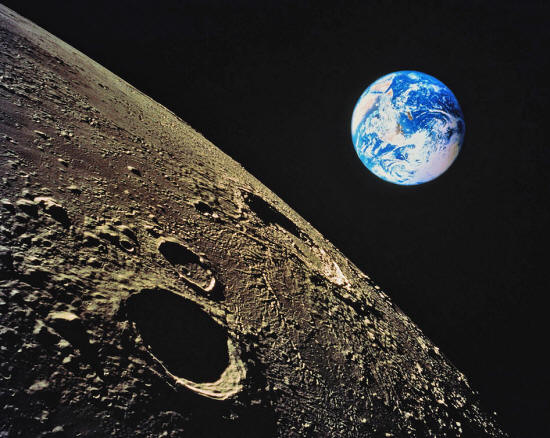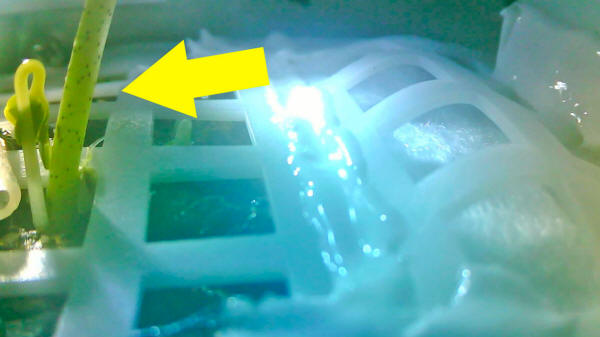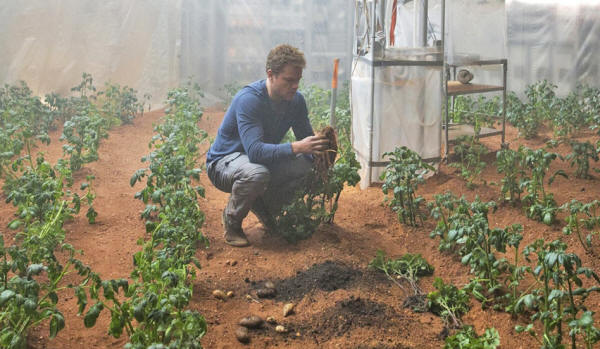|

by Rafi Letzter
January 03,
2019
from
LiveScience Website

Is the moon really
"a
harsh mistress?"
(Composite image)
Credit: World Perspectives
Getty Images
China's
Chang'e-4 lander touched down
on the far side of the moon (Jan. 3
Beijing time, Jan. 2 U.S.), and it's got some living things on
board.
A small "tin" in the lander contains seeds of potatoes and
rockcress (Arabidopsis
thaliana, a flowering plant related to cabbage and
mustard, as well as a model organism for plant biology), as well as
silkworm eggs.
The idea, according to
a report in The Telegraph
earlier this year, is that the plants will support the silkworms
with oxygen, and the silkworms will in turn provide the plants with
necessary carbon dioxide and nutrients through their waste.
The researchers will
watch the plants carefully to see whether the plants successfully
perform photosynthesis, and grow and bloom in the lunar environment.
"We want to study the
respiration of the seeds and the photosynthesis on the moon,"
Xie Gengxin, chief designer of the experiment, told Xinhua, a
Chinese state-run news agency.
The "biosphere"
experiment was the product of a collaboration between 28 Chinese
universities, led by southwest China's
Chongqing University, according to
Xinhua.
The experiment, which is
tucked inside a 1.4-pint (0.8 liters) aluminum alloy cylinder,
weighs about 7 lbs. (3 kilograms) and includes dirt, nutrients and
water.
Sunlight will filter into
the container through a "tube," and small cameras will watch the
little environment.
That data will beam back
to Earth by means of the complicated relay system China has set up
to communicate with an experiment that has no direct line of sight
to Earth.
"Why potato and
Arabidopsis? Because the growth period of Arabidopsis is short
and convenient to observe.
And potato could
become a major source of food for future space travelers," said
Liu Hanlong, chief director of the experiment and vice president
of Chongqing University, as reported by Xinhua.
"Our experiment might
help accumulate knowledge for building a lunar base and
long-term residence on the moon."
Rockcress has been grown
in space before, including in one experiment on the International
Space Station that showed the plants' leaves appearing to rise and
fall as they detected the moon's gravity (Lunar
Gravity affects leaf movement of Arabidopsis thaliana in the
International Space Station).
But whether the flowering
plant will flourish in the environment of the far side of the moon
remains an 'open question' (read below report...!)
For now, though, this means that there's life in at least one other
place in the solar system (even if it's only because 'we' put it
there)...
-
A First for Humankind -
China Successfully Sprouts a Seed on the Moon
by Stephen
Johnson
January 15,
2019
from
BigThink Website

-
China's Chang'e
4 lunar lander touched down on the far side of the
moon on January 3.
-
In addition to
a lunar rover, the lander carried a biosphere
experiment that contains five sets of plants and
some insects.
-
The experiment
is designed to test how astronauts might someday
grow plants in space to sustain long-term
settlements.
China's Chang'e
4 biosphere experiment
marks a first
for humankind...
A plant has sprouted on the moon in a Chinese probe, marking the
first time a plant has grown on the lunar surface, according to an
image and statements released the China National Space
Administration (CNSA)
on Tuesday.
The image appears to show cotton shoots successfully growing
within an airtight canister aboard China's
Chang'e-4 lunar lander, which
touched down on the far side of the moon on January 3 (2019).
The plant is part of the
mission's "moon surface micro-ecological circle" experiment, which
also includes,
-
rapeseed
-
potato
-
arabidopsis
-
yeast
-
fruit flies
Chinese professor Liu
Hanlong, head of the experiment, announced on Tuesday that the
cotton seeds were the first to sprout, and also that
rapeseed and potato seeds had sprouted and were growing well as of
Saturday.
It's an experiment designed to test how humans might someday grow
food
on lunar bases, a necessity for any
long-term settlement.
"We have given
consideration to future survival in space.
Learning about these
plants' growth in a low-gravity environment would allow us to
lay the foundation for our future establishment of space base,"
Hanlong told the South China Morning Post.
The micro-ecological
circle in the experiment was carefully designed to withstand the
harsh conditions of the Moon, with the six organisms behaving
synergistically as "producers, consumers and decomposers":
The plants produce
the oxygen and food, sustaining the fruit flies.
Meanwhile, the yeast
decomposes waste from the flies and dead plants, creating more food
for the insects.
The experiment shows that astronauts on future missions would likely
be able to grow potatoes for food, cotton for clothing and rapeseed
for oil. It's not the first time a plant has been grown in space.
Astronauts aboard the
International Space Station have
successfully grown,
-
lettuce
-
zinnia
-
rice
-
onions
-
peas
-
cabbage
-
sunflower
-
cucumbers
What's more, a panel of
algae positioned outside of the space station managed
to survive some 530 days, withstanding the vacuum and temperatures
ranging from -68 to 116.96 degrees Fahrenheit during the day and
night, respectively.
The challenge and necessity of space plants

Matt Damon in The Martian,
growing
potatoes on Mars.
The
Chinese scientists have also sprouted
a
potato seed on the Moon
in the
same experiment series.
If humans are going to colonize
the
Moon or other planets, they're going to need a reliable
and replenishable source of high-quality food.
Developing the technology
and skillsets required for such a food source is a major obstacle
that all space agencies are working to overcome.
Obviously, it'd be much easier to plan and execute a trip to, say
Mars, if space agencies could simply send astronauts off
with a cache freeze-dried food that would last decades.
But the quality of the
nutrients and vitamins in these preserved foods degrades over time,
even though the preservation process does prevent microbiological
changes.
That's a problem,
considering astronauts returning from a Mars mission would likely be
eating freeze-dried food that's more than five years old. That is,
unless they grow their own plants.
Of course, growing fruits and vegetables requires the right amounts
of oxygen, carbon dioxide, humidity, light and temperature control,
and gravity - all of which can be extremely difficult to control in
space.
Another problem is soil:
It's necessary for
plant growth, but it also takes up precious space, and plants
won't readily grow in the soil on the moon or Mars.
That's why NASA has been
exploring techniques that use as little soil as possible.
In 2016, one of those experiments yielded red-romaine lettuce for
the astronauts aboard the International Space Station, thanks
to NASA's plant growth system dubbed "Veggie".
All of this said,
what China has showed the world this week
is important because learning how to grow plants in space,
particularly extraterrestrial bodies, is necessary for the
physiological health of astronauts on long-term missions.
Interestingly, there's
reason to think these space gardening efforts are also important for
astronauts' psychological well-being - at least in the sense that
fresh plants might, in some way, keep them connected to Earth.
"We've heard from a
lot of astronauts who comment to the effect of, 'I thought that
I'd miss the cheeseburger or pizza the most when I came back,
but what I really wanted was a fresh salad'," Gioia Massa, a
NASA scientist studying food production in space at the Kennedy
Space Center, told The Verge.
"So, we think having
that fresh, juicy, crunchy texture in their diet can be really
important."
|




